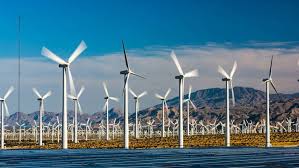An industry trade body recently released a report stating that 2023 was the best year ever for new wind projects, with 117 gigawatts of new wind generating capacity constructed worldwide, up 50% from the previous year.
The condition of the worldwide wind industry and the obstacles to its growth are examined in the most recent worldwide Wind Report, which was released on Tuesday by the Global Wind Energy Council.
As per the research, the growing number of wind installations “indicates that the global climate change fight is headed in the right direction.”
Laptops 1000However, the authors cautioned that to meet the COP28 commitment to triple the installed renewable energy generation capacity worldwide by 2030 and to meet the Paris Agreement’s ambition of limiting global warming to 1.5 degrees Celsius (2.7 Fahrenheit), the wind industry must increase its annual growth to at least 320 gigawatts by that same year.
GWEC CEO Ben Backwell stated, “It’s encouraging to see the wind industry growing, and we are happy to have set a new yearly record, but much more work needs to be done to unlock growth.”
Nevertheless, the study demonstrates that wind is “becoming more recognized and valued globally for the benefits it offers as a sustainable energy source,” according to George Aluru, CEO of the Electricity Sector Association of Kenya, a trade association for individual electricity buyers.
“By ensuring sustainable growth, this increasing supply of renewable energy promotes climate goals,” he stated.
Wind energy and other renewable energy sources are viewed as essential to lowering the amount of electricity generated from fossil fuels and mitigating climate change, given the escalating effects of climate change.
Laptops 1000In many places of the world, renewable energy is the most affordable source of electricity; in most others, it’s among the cheapest.
Currently, 1,021 gigawatts of wind power have been generated globally cumulatively.
The report indicates that the wind industry is “picking up pace” by drawing investments and maturing, and that could have a snowball effect leading to future growth, according to Christian Andresen, research manager at SINTEF Energy Research, an independent institute for applied research in the energy sector based in Norway.
He claimed that this shows that there is room to increase to meet climate targets for the planet.
Andresen stated, “This is a crucial step in the transition towards a net-zero emission society.”
China led all other nations in 2023 for both new onshore and offshore wind power installations, as it did in 2022. With 65% of new installations, it was followed by Germany, Brazil, and the United States, in that order. 77% of all new installations worldwide occurred in these four nations combined last year.
The study observes that the expansion of wind power installations is focused on a small number of major nations and attributes this to robust market frameworks that enable the scalability of wind installations in those nations. China, the United States, Germany, India, and Spain continued to be the top five markets at the end of the previous year.
Nevertheless, a few more nations and areas are rising, having had unprecedented growth in 2023.
In 2023, wind generating capacity installed in Africa and the Middle East approached 1 gigawatt, nearly double the amount installed the year before.
The analysis anticipates that new onshore wind additions for Africa and the Middle East will expand fivefold by 2028 compared with 2023, with projects in South Africa, Egypt, and Saudi Arabia.
Laptops 1000Kenya is one of the markets to keep an eye on since the research stated that wind power accounts for about 17% of the country’s electricity. The 310-megawatt Lake Turkana Wind Power Project is the largest wind farm in Africa, and the research highlights further large-scale wind projects that are planned for the nation, such as a 1-gigawatt wind park by regional power producer KenGen.
However, the report stated that developing and rising nations must pay higher interest rates and suffer higher capital costs to establish their wind farms. Additionally, the construction of wind power plants is costly and requires large upfront investments.
According to Erin Baker, a professor of industrial engineering and operations research at the University of Massachusetts, wind energy also faces supply chain and grid issues. The electrical system must innovate to integrate intermittent wind energy onto the grid while maintaining reliability. She gave offshore wind as one example, which requires very specific manufacturing and equipment as well as knowledge of finance and business concepts.
However, the report’s findings indicate that wind energy is growing faster than ever, which is forcing nations to build the supply chains necessary to support this expansion. As a result, she predicted that as more wind energy projects are developed globally, costs will go down and technology will advance.
“There is hope that the supply chain is being established as evidenced by the wind industry’s recent growth and the support from various nations,” stated Baker.


















